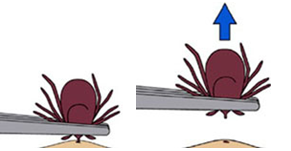You may think ticks are insects but they’re actually bloodsucking arachnids. Adult ticks have eight legs and two body segments just like spiders, mites and chiggers.
According to the CDC, most ticks go through four life stages: egg, six-legged larva, eight-legged nymph, and adult. After hatching from the eggs, ticks must eat blood at every stage to survive. Ticks that require this many hosts can take up to 3 years to complete their full life cycle, and most will die because they don't find a host for their next feeding. And ticks aren’t choosy about their host - they can feed on mammals, birds, reptiles, and amphibians.

Did you know…
…tick watchers – from foresters to disease ecologists – reported a population explosion among black-legged ticks, formerly known as deer ticks, last year?! The cause isn’t clear but it could be due to a bumper crop of acorns that caused an increase of vermin (mice, squirrels, etc.) combined with the mild winter, but ticks are out there … and they’re hungry.
…white-footed mice and other small mammals, not deer, are now known by scientists to be major carriers of Lyme disease?! Birds are major carriers too.
… University of Virginia researchers claim a bite from the lone star tick, so-called for the white spot on its back, may trigger an allergic reaction … to meat?!
Nasty suckers
Ticks grab onto a host (animals or people walking through brush) and sink their harpoon-like barbed mouth and head into the host’s skin to dine until they’re full of blood. Then they drop off and wait for the next meal to pass by. Since ticks feast on one spot for days, they can spread bacteria and diseases from host to host (like from animals to humans) - even by touching them.
According to the CDC, most ticks prefer to have a different host animal at each stage of their life, as shown below:

This diagram shows the life cycle of blacklegged ticks that can transmit anaplasmosis, babesiosis, and Lyme disease.
The main threat of ticks is the risk of illness or disease (like Lyme disease, Rocky Mountain spotted fever or tick paralysis) so the best defense is reducing exposure to ticks or finding and removing them as quickly as possible.
Things to watch for…
- Bite or sting mark or ticks
- Pain or burning feeling
- Redness or Swelling or Rash
- Stomach pain or puking
- Flu-like symptoms - fever, dizziness, weakness, headache, body aches, swollen lymph nodes, etc.
- Change in skin color or bruising or rash (may look kind of like a bulls-eye)
What to do for ticks…
Key things are to find a tick before it feasts for days and to remove a tick slowly with head intact so it doesn’t spew bacteria into the blood stream.
- DO NOT use petroleum jelly, liquid soap, nail polish or heat - they don’t work!
- Use tweezers or commercial tick remover (or at least cover fingers with a tissue).
- Grasp tick close to skin where head is buried - don’t squeeze it!
- Slowly pull tick straight up until skin puckers -- it may take several seconds but tick will loosen its barbs and let go.

- DO NOT throw tick away since it may need to be tested! Put it in zippered baggie with moist paper towel, date it, and put in refrigerator.
- Wash bite wound and tweezers with soap and water.
- Call local health department or vet to ask if tick needs to be identified or tested. If not, throw away baggie.
- Watch for rash, infection or symptoms for a week or so.
Things to do to avoid ticks…
- Wear light-colored pants and long-sleeve shirt (to see ticks), a hat (to keep out of hair) and tuck in (pants in socks and shirt in pants).
- Do full body checks couple times a day during tick season.
- Use tick repellent with DEET.
TickApp
A handy tick tool is by Dr. Pete Teel, Texas AgriLife Research entomologist at College Station and hero tick stalker extraordinaire. Dr. Teel has created a one-place-for-all info-tool called the TickApp, a central cyber point that can be accessed any time/any day for all the tick information you need whether you are a dog owner, hunter, farmer or rancher, hiker, soldier, or medical professional.
Teel says the mobile smartphone app is available at no charge and is easy to use with little searching required. “Whether you are a healthcare professional needing fast tick identification information, an urban pet owner slogging through the bewildering arsenal of control alternatives or a South Texas cattleman facing financial hardship due to ticks, the app is meant for you,” Teel said in a recent AgriLife update. “It’s all very user-friendly and opens with just six easy-to-follow tabs that are quick to navigate. There’s a brief introduction, then a tick ID tab followed by tabs on tick biology, prevention and protection, removal and finally control and management practices.”
The TickApp can be downloaded at http://tickapp.tamu.edu.
Helpful Resources & Sources:
CDC’s Ticks site www.cdc.gov/ticks/
CDC’s Lyme Disease page www.cdc.gov/lyme/
CDC NCID’s Division of Vector-Borne Diseases site at www.cdc.gov/ncezid/dvbd/


